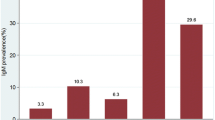Abstract
Rubella Virus (RUBV) is a common cause of childhood rash and fever in non-immunized populations, and its public health importance relates to teratogenic effects of primary rubella infection in women with early pregnancy. Infection of the fetus may lead to congenital rubella syndrome (CRS). This work aimed to assess the degree of risk associated in acquiring rubella virus infection by the women during pregnancy and developing CRS among their children in Bangladesh. The study population (n = 275) included pregnant mothers (15–38 years) from various socioeconomic backgrounds attending a women health care based hospital. All subjects were personally interviewed, clinically examined and a standardized questionnaire was filled up for each of them. From each participant 3 ml blood was taken and serum was separated. Commercially available ELISA kit was used for the qualitative and quantitative determination of IgM and IgG class antibodies against RUBV in collected serum samples. 209 women were found to contain detectable level of antiRUBV IgG antibodies, but did not possess IgM antibodies against rubella. Only 9% participants were vaccinated previously against rubella virus among the whole antenatal population studied. Ninety-two percent of these vaccinated pregnant women contained serum anti-rubella IgG antibody which was significantly (P = 0.05) higher than that of the nonvaccinated study population (75%). Pregnant women from lower middle and poor socioeconomic class had significantly (P = 0.05) more intra uterine growth retardation (IUGR) of fetus than the upper middle class. 20% of the women of child bearing age examined in this work were not yet exposed to RUBV and at risk of acquiring this virus during pregnancy and subsequently transmitting the virus to the fetus. Our work demonstrates rubella attack rate among antenatal population in Bangladesh as 14.5 in 1000 during pregnancy. A proper and reliable vaccination policy against rubella virus is not yet adopted at the national level in many developing countries including Bangladesh. This work identifies the requirement of detailed study for the identification of intrauterine rubella infection and its related influence on perinatal morbidity and mortality. Thorough epidemiological studies are also considered necessary prior to the development and acceptance of national immunization program against rubella virus in Bangladesh.

Similar content being viewed by others
References
Lee JY, Bowden DS (2000) Rubella virus replication and links to teratogenicity. Clin Microbiol Rev 13:571–587
Tseng H, Chang C, Tan H, Yang S, Chang H (2006) Seroepidemiology study of rubella antibodies among pregnant women from seven Asian countries: evaluation of the rubella vaccination program in Taiwan. Vaccine 24:5772–5777
Tzeng W, Zhou Y, Icenogle J, Frey TK (2005) Novel replicon-based reporter gene assay for detection of rubella virus in clinical specimens. J Clin Microbiol 43:879–885
Brooks FG, Butel JS, Morse SA, Melnick JL, Jawetz E, Adelberg EA (2004). Rubella virus. In: Medical Microbiology. Chapter 40, 23rd (edn). McGraw-Hill professional, New York, pp 566–568
Menser MA, Hudson JR, Murphy AM, Upfold LJ (1985) Epidemiology of congenital rubella and results of rubella vaccination in Australia. Rev Infect Dis 7:37–41
Ashrafunnessa, Khatun S, Islam MN, Chowdhury S (2000) Seroprevalence of rubella antibodies among antenatal population attending a tertiary level hospital in Dhaka city. Bangladesh Med Res Counc Bull 26:75–81
Assaad F, Jungars-Esteves KL (1985) Rubella world impact. Rev Infect Dis 7:29–36
Dominguez A, Plans P, Costa J, Torner N, Cardenosa N, Batalla J, Plasencia A, Salleras L (2006) Seroprevalence of measles, rubella, and mumps antibodies in Catalonia, Spain: results of a cross-sectional study. Eur J Clin Microbiol Infect Dis 25:310–317
Hobman TC, Chantler JK (2007) Rubella Virus. In: Knipe DM, Howley PM (eds) Fields Virology, 5th edn. Lippincott Williams and Wilkins, USA, pp 1069–1101 Chapter 32
Mathur A, Chaturvedi UC, Mehrotra RML (1974) Serological study for the prevalence of rubella at Lucknow. Indian J Med Res 62:307–312
Seth P, Balaya S, Mohapatra LN (1971) Seroepidemiological study of rubella infection in female subjects of Delhi and its surrounding villages. India J Med Res 59:190–194
Boonruang S, Buppasiri P (2005) Rubella antibodies in normal pregnant women at Srinagarind Hospital, Khon Kaen, Thailand. J Med Assoc Thai 8(4):455–459
Thant KZ, Oo WM, Myint TT, Shwe TN, Han AM, Aye KM, Aye KT, Moe K, Thein S, Robertson SE (2006) Active surveillance for congenital rubella syndrome in Yangon, Myanmar. Bull World Health Organ 84(1):12–20
Yasodhara P, Ramalakshmi BA, Naidu AN, Rahman L (2001) Prevalence of specific IgM due to Toxoplasma, Rubella, CMV and C. trachomatis infections during pregnancy. Indian J Med Microbiol 19:52–56
Wilson KM, Camillo CD, Doughty L, Dax EM (2006) Humoral immune response to primary rubella virus infection. Clin Vaccine Immunol 13:380–386
World Health Organization (2000) Rubella vaccines: WHO position paper. Wkly Epidemiol Rec 75:161–169
Acknowledgments
We are grateful to the participants of this study, and to the laboratory staff of Ad-din Hospital, Dhaka for their help and very kind cooperation.
Author information
Authors and Affiliations
Corresponding author
Rights and permissions
About this article
Cite this article
Imam, H., Yasmin, M., Ahsan, C.R. et al. Pregnant Women in and Around Dhaka City: Are Their Children at Risk of Developing Congenital Rubella Syndrome?. Indian J Microbiol 50, 443–448 (2010). https://doi.org/10.1007/s12088-011-0094-5
Received:
Accepted:
Published:
Issue Date:
DOI: https://doi.org/10.1007/s12088-011-0094-5




